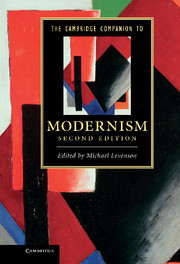Book contents
- Frontmatter
- Introduction
- 1 The metaphysics of Modernism
- 2 The cultural economy of Modernism
- 3 The Modernist novel
- 4 Modern poetry
- 5 Modernism in drama
- 6 Modernism and the politics of culture
- 7 Modernism and religion
- 8 Modernism and mass culture
- 9 Modernism and gender
- 10 Musical motives in Modernism
- 11 Modernism and the visual arts
- 12 Modernism and film
- 13 Modernism and colonialism
- Further reading
- Index
2 - The cultural economy of Modernism
Published online by Cambridge University Press: 28 September 2011
- Frontmatter
- Introduction
- 1 The metaphysics of Modernism
- 2 The cultural economy of Modernism
- 3 The Modernist novel
- 4 Modern poetry
- 5 Modernism in drama
- 6 Modernism and the politics of culture
- 7 Modernism and religion
- 8 Modernism and mass culture
- 9 Modernism and gender
- 10 Musical motives in Modernism
- 11 Modernism and the visual arts
- 12 Modernism and film
- 13 Modernism and colonialism
- Further reading
- Index
Summary
Charles Dickens, rising to his feet, stood at the table and surveyed the vast hall in which the leading citizens of Birmingham had gathered in early 1853 to pay him homage at a banquet. It was his duty to thank them now, and he proceeded to offer his tribute.
To the great compact phalanx of the people, by whose industry, perseverance, and intelligence, and their result in money-wealth such places as Birmingham, and many others like it, have arisen - to that great centre of support, that comprehensive experience, and that beating heart, - Literature has turned happily from individual patrons, sometimes munificent, often sordid, always few, and has found there at once its highest purpose, its natural range of action and its best reward.
"The people," Dickens concluded triumphantly, "have set Literature free." And in return for that gift of liberty, he opined, "Literature cannot be too faithful to the people."
Within thirty years of Dickens ’s death in 1870, authors were far less confident about the beneficent effects of literature’s dependency on “the people,” or the prospects for a collective literary culture. In the intervening period, as many critics have noted, British popular fiction undergoes an unmistakable transformation, one in which the novel gradually acquires a class structure analogous to that of the social world surrounding it. By the decade 1900–10, the years when Conrad is writing his best work to little acclaim, the polarization between “high” and “low” literature is firmly in place, and the Modernist project issues its claim to aesthetic dignity by repudiating that Victorian literature, above all fiction, that had sold itself to a mass reading public. When
- Type
- Chapter
- Information
- The Cambridge Companion to Modernism , pp. 33 - 68Publisher: Cambridge University PressPrint publication year: 2011
- 2
- Cited by

